Stocks were looking firm on Tuesday after Monday’s drop turned out to not be as deep as feared. Investors are proving able and willing to step in and look for opportunity in pullbacks and overlooked stock stories. Each morning 24/7 Wall St. reviews dozens of brokerage analyst reports for new investment and trading ideas for its readers. Some of these reports cover stocks to buy, but some also cover stocks to sell or to avoid.
These are this Tuesday’s top analyst upgrades, downgrades and initiations covered by 24/7 Wall St.
Alcoa Inc. (NYSE: AA) was raised to Buy from Neutral and the price target was raised to $18 from $16 at Bank of America Merrill Lynch.
Apple Inc. (NASDAQ: AAPL) was started as Hold with a $110 price target (versus a $100.11 close) at Jefferies. While this is a Hold rating rather than a Buy rating, note that the consensus analyst price target of $110.79 is less than $1 higher than this target issued today — and this target still implies 10% upside plus the dividend.
Computers Science Corp. (NYSE: CSC) was raised Outperform from Market Perform at Raymond James.
Lockheed Martin Corp. (NYSE: LMT) was raised to Buy from Hold at Stifel.
Toyota Motor Corp. (NYSE: TM) was raised to Overweight from Neutral at J.P. Morgan.
Athlon Energy Inc. (NYSE: ATHL) was downgraded to Neutral from Buy at UBS. Canaccord Genuity downgraded it to Hold from Buy as well.
Century Aluminum Co. (NASDAQ: CENX) was raised to Buy from Neutral and the price target was raised to $30 from $21 (versus a $23.86 close) at Merrill Lynch.
Great Plains Energy Inc. (NYSE: GXP) was maintained as Buy but the price target was cut to $29 from $32 (versus a $24.29 close) at Argus, due to earnings pressure from increases in transmission and distribution expenses and higher generation expenses.
Kellogg Co. (NYSE: K) was downgraded to Underweight from Equal Weight and the price target was set at $58 (versus a $61.81 close) at Morgan Stanley.
Mellanox Technologies Ltd. (NASDAQ: MLNX) was raised to Overweight from Neutral at Piper Jaffray.
NiSource Inc. (NYSE: NI) was raised to Outperform from Neutral at Credit Suisse, on the heels of its spin-off news.
NuVasive Inc. (NASDAQ: NUVA) was raised to Buy from Hold at Brean Capital.
Patterson-UTI Energy Inc. (NASDAQ: PTEN) was raised to Equal Weight from Underweight at Morgan Stanley.
Raytheon Co. (NYSE: RTN) was raised to Buy from Hold at Stifel.
Seattle Genetics Inc. (NASDAQ: SGEN) was downgraded to Underperform from Neutral at Merrill Lynch.
Teekay Corp. (NYSE: TK) was raised to Buy from Hold at Deutsche Bank
This blog provides analysis, advice, trade ideas and other happenings. I frequently publish research at major investing websites. The most featured sectors on this website will depend on what is currently trending and hot in the market.
Custom Investing Search Tool
Tuesday, September 30, 2014
Gilead is kicking more ass
Call it Gilead Sciences' (NASDAQ: GILD ) stealth play.
Gilead is the king of the HIV business. Its wildly successful Sovaldi launch is without a doubt the biggest biotech event of the year. But the company's experimental cancer drug pipeline is a different story, one that has encountered numerous setbacks.
Perhaps that's why the EU's recent approval of Gilead's targeted P13K inhibitor, Zydelig, flew mostly under the radar. Despite treatment for leukemia and other blood cancers being one of the fastest growing markets for cancer drugs, the event received little analyst attention. I believe that could be a mistake, because Gilead has been laying a foundation for oncology since 2011, with a savvy string of deals that set the stage for success even greater than Sovaldi and HIV drugs. Targeted oncology is entering an era where significant advances are being made, and while a ton of things could go wrong, Zydelig's approval is more than just an isolated stroke of luck. It's the first step in building a solid franchise.
The European Commission approved Zydelig (idelalisib) in mid-September; two months after the FDA approved the first-in-class oral treatment for several incurable blood cancers, including relapsed chronic lymphocytic leukemia (CLL). CLL is a slow-moving disease that can require treatment over years, opening up a chance for billions of dollars in revenue.
According to EvaluatePharma estimates, the drug could generate $1.2 billion in peak sales by 2020. Stanford Bernstein analyst Geoff Porges sees a higher and faster growth curve, based on Zydelig's potential for non-Hodgkin's lymphoma. He predicts $1.5 billion in Zydelig sales by 2017.
In the United States, the FDA's green lighting of Zydelig extends beyond relapsed CLL to follicular lymphoma (FL), and relapsed small lymphocytic lymphoma (SLL). Coming out of the gate with three indications in the U.S. and two in Europe (FL and CLL) could put the giant biotech on track to become a cancer powerhouse.
The real victory, however, goes beyond the numbers.
Fantastic results
Zydelig works by blocking overactive PI3K-delta signaling, cutting off a key contributor to cancer growth in B-cell leukemias and lymphomas. The drug's approval in the EU came from a placebo-controlled trial in 220 patients that stopped early, after the drug showed significantly longer progression-free survival.
Some of the responses seen with Zydelig were "incredible" and came within a week, according to Richard Furman, MD, from the Weil Cornell Medical College in New York City. Dr. Furman, author of the results for The New England Journal of Medicine, commented, "It is remarkable how quickly idelalisib (Zydelig) worked in this heavily treated group of patients, many of whom were resistant to chemotherapy... Their cancer quickly melted away."
The push into blood-cancer research has helped redefine the lives of people who have these diseases, said Hildy Dillon, senior vice president of patient services at the Leukemia & Lymphoma Society. "I've been in oncology for over 30 years, and people did not survive these diseases," Dillon said. "And now, as we develop newer therapies, we are extending the lives of these patients."
The results in blood cancer are heartening, but they're also in stark contrast to another Gilead oncology candidate, simtuzumab, which failed its Phase 2 study for advanced pancreatic cancer this month. Simtuzumab is still in clinical trials for other areas of unmet medical needs, including idiopathic pulmonary fibrosis, but it has a lot to prove.
In fact, simtuzumab's failure with pancreatic cancer has left the company open to the criticism that it will end up being successfully cutting edge in everything except oncology.
Side effects and competition
In terms of Zydelig, targeted or not, patients could encounter numerous serious side effects. In the U.S., a black-box warning on the product that highlights the possibility of colitis, lung inflammation, and potentially fatal liver problems could slow acceptance.
Zydelig has formidable competition from Johnson & Johnson's (NYSE: JNJ ) and Pharmacyclics' (NASDAQ: PCYC ) Imbruvica (ibrutinib). Imbruvica doesn't have a black box warning. And there's more competition coming from AbbVie with ABT-199, which is in late-stage development.
Recognizing the challenge, Gilead has priced Zydelig slightly lower than Imbruvica, at $7,200 compared with $8,200. Another point in Zydelig's favor is that while the European Commission approved Zydelig quickly, Imbruvica has yet to receive EU approval.
With Sovaldi sales trouncing estimates, potentially reaching $10 billion this year, Gilead could easily achieve its goal of doubling its 2013 revenue. But having such a huge single contributor makes Gilead more vulnerable, especially given the pushback on the drug's $1,000-a-pill price tag. Despite the striking guidance and quarter numbers, it's wise not to lose sight of the rest of the company's pipeline.
Gilead is the king of the HIV business. Its wildly successful Sovaldi launch is without a doubt the biggest biotech event of the year. But the company's experimental cancer drug pipeline is a different story, one that has encountered numerous setbacks.
Perhaps that's why the EU's recent approval of Gilead's targeted P13K inhibitor, Zydelig, flew mostly under the radar. Despite treatment for leukemia and other blood cancers being one of the fastest growing markets for cancer drugs, the event received little analyst attention. I believe that could be a mistake, because Gilead has been laying a foundation for oncology since 2011, with a savvy string of deals that set the stage for success even greater than Sovaldi and HIV drugs. Targeted oncology is entering an era where significant advances are being made, and while a ton of things could go wrong, Zydelig's approval is more than just an isolated stroke of luck. It's the first step in building a solid franchise.
The European Commission approved Zydelig (idelalisib) in mid-September; two months after the FDA approved the first-in-class oral treatment for several incurable blood cancers, including relapsed chronic lymphocytic leukemia (CLL). CLL is a slow-moving disease that can require treatment over years, opening up a chance for billions of dollars in revenue.
According to EvaluatePharma estimates, the drug could generate $1.2 billion in peak sales by 2020. Stanford Bernstein analyst Geoff Porges sees a higher and faster growth curve, based on Zydelig's potential for non-Hodgkin's lymphoma. He predicts $1.5 billion in Zydelig sales by 2017.
In the United States, the FDA's green lighting of Zydelig extends beyond relapsed CLL to follicular lymphoma (FL), and relapsed small lymphocytic lymphoma (SLL). Coming out of the gate with three indications in the U.S. and two in Europe (FL and CLL) could put the giant biotech on track to become a cancer powerhouse.
The real victory, however, goes beyond the numbers.
Fantastic results
Zydelig works by blocking overactive PI3K-delta signaling, cutting off a key contributor to cancer growth in B-cell leukemias and lymphomas. The drug's approval in the EU came from a placebo-controlled trial in 220 patients that stopped early, after the drug showed significantly longer progression-free survival.
Some of the responses seen with Zydelig were "incredible" and came within a week, according to Richard Furman, MD, from the Weil Cornell Medical College in New York City. Dr. Furman, author of the results for The New England Journal of Medicine, commented, "It is remarkable how quickly idelalisib (Zydelig) worked in this heavily treated group of patients, many of whom were resistant to chemotherapy... Their cancer quickly melted away."
The push into blood-cancer research has helped redefine the lives of people who have these diseases, said Hildy Dillon, senior vice president of patient services at the Leukemia & Lymphoma Society. "I've been in oncology for over 30 years, and people did not survive these diseases," Dillon said. "And now, as we develop newer therapies, we are extending the lives of these patients."
The results in blood cancer are heartening, but they're also in stark contrast to another Gilead oncology candidate, simtuzumab, which failed its Phase 2 study for advanced pancreatic cancer this month. Simtuzumab is still in clinical trials for other areas of unmet medical needs, including idiopathic pulmonary fibrosis, but it has a lot to prove.
In fact, simtuzumab's failure with pancreatic cancer has left the company open to the criticism that it will end up being successfully cutting edge in everything except oncology.
Side effects and competition
In terms of Zydelig, targeted or not, patients could encounter numerous serious side effects. In the U.S., a black-box warning on the product that highlights the possibility of colitis, lung inflammation, and potentially fatal liver problems could slow acceptance.
Zydelig has formidable competition from Johnson & Johnson's (NYSE: JNJ ) and Pharmacyclics' (NASDAQ: PCYC ) Imbruvica (ibrutinib). Imbruvica doesn't have a black box warning. And there's more competition coming from AbbVie with ABT-199, which is in late-stage development.
Recognizing the challenge, Gilead has priced Zydelig slightly lower than Imbruvica, at $7,200 compared with $8,200. Another point in Zydelig's favor is that while the European Commission approved Zydelig quickly, Imbruvica has yet to receive EU approval.
With Sovaldi sales trouncing estimates, potentially reaching $10 billion this year, Gilead could easily achieve its goal of doubling its 2013 revenue. But having such a huge single contributor makes Gilead more vulnerable, especially given the pushback on the drug's $1,000-a-pill price tag. Despite the striking guidance and quarter numbers, it's wise not to lose sight of the rest of the company's pipeline.
Monday, September 29, 2014
10 sweet iPhone cases and who makes them. Will they protect the screen??
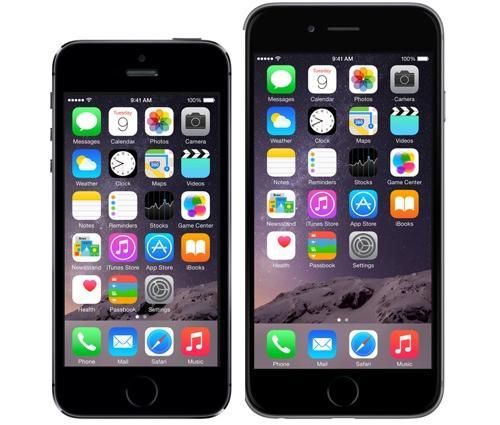
Smartphone cases have gone from a necessary evil that protect your phone from the inevitable bumps and bruises of everyday life to sophisticated fashion statements.
And the newest crop of cases and bumpers for the iPhone 6 and 6 Plus are no different. We’re talking about cases that range from beefy pieces of rubbery plastic to shells made of all-natural wood and leather, and everything in between.
In other words, if you’re looking for some new cases for your iPhone 6 or 6 Plus, you might want to start with these.
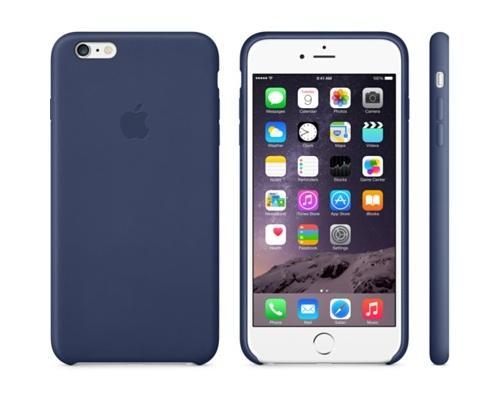
Apple’s own leather cases for the iPhone 6 and 6 Plus are as simple as cases get. Priced at $45 and $49 for the 6 and 6 Plus, respectively, Apple promises that these leather cases will protect your phone without adding much bulk.
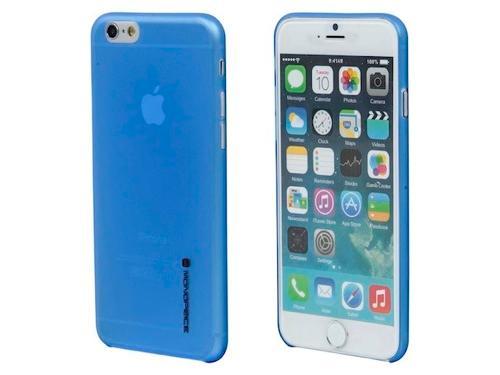
Monoprice’s ultra-thin shatterproof case for the iPhone 6 is available for just $5.60 and will protect your precious smartphone against the nicks and cuts that result from everyday drops. It won’t, however, protect your screen much. So if your iPhone face-plants, its screen is still at risk of shattering. But if you want a case for your phone and don’t want to spend $50, you can’t go wrong with this one.

OtterBox is known for offering super-sturdy smartphone cases, and its Defender Series is the company’s beefiest of all. Priced at $59.90 and $69.60 for the iPhone 6 and 6 Plus, respectively, the Defender Series packs three layers of protection, a built-in screen protector, and port covers to protect against dust. And for everyone stuck in 2009, the Defender also includes a belt holster that doubles as a kickstand.
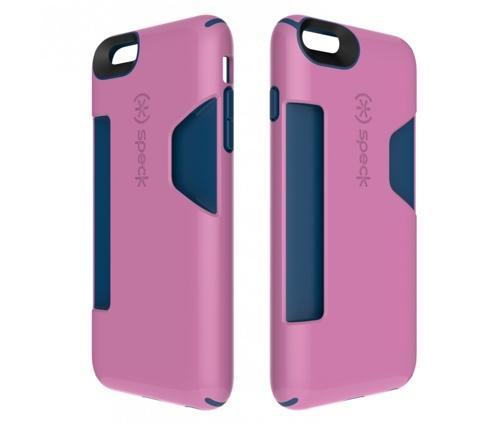
Want to protect your iPhone and ditch your wallet? The Speck CandyShell Card Case has you covered. Offering an impact-resistant outer coating and a raised bezel to protect your phone’s display, the Card Case is seriously durable. What’s more, its backside features room for three credit cards and some folded bills. Priced at $39 for the iPhone 6 and $44 for the iPhone 6 Plus, it’s a 2-for-1 special for your smartphone.

If you want to add some extra pizazz to your iPhone 6 or 6 Plus, look no further than Case-Mate’s Brilliance Case. At $80 for both iPhone 6 and 6 Plus models, the Brilliance Case’s back panel is covered in shimmering crystals. The Brilliance isn’t just a pretty face, though. It also offers dual-layer protection, and its bezel extends past the iPhone’s display to keep it from smacking against the floor if you drop it face-down.
![Stowaway [Advance] iPhone case from Incipio](https://s.yimg.com/cd/resizer/2.0/FIT_TO_WIDTH-w500/e739a9071438f6e957e96f509455458472e898f0.jpg)
7. Radius v2

The folks at BiteMyApple call this case the bikini of iPhone cases, and for good reason. The Radius v2 uses the bare minimum of material needed to cover and protect your iPhone 6 ($79) or 6 Plus ($89) from drops, bumps, and bruises. Unlike most cases, the Radius v2 doesn’t completely cover up the iPhone 6’s beautiful shell. The trade-off is that it also leaves the phone more exposed, making it susceptible to scratches and nicks. That said, it certainly looks cool.

The iPhone 6 and 6 Plus have taken some knocks for being a bit more slippery than their predecessors. Griffin Technology’s Identity Performance case ($40) seeks to solve that problem with a no-skid back panel. And if your phone does slip from your grasp, the Identity Performance’s shell will protect it from drops as high as 4 feet. An included reusable screen protector will also keep your iPhone’s display safe from scratches and nicks.

Grovemade’s Walnut and Leather iPhone Case lets your iPhone go au naturel without you having to fear that it’ll break if it slips from your hand. That’s because, Grovemade’s cases are made using all-natural walnut wood. Get it, naturel, natural? … Anyway, the Walnut and Leather iPhone Case protects your iPhone from falls while also doubling as a stand thanks to its flexible leather cover. These handcrafted cases cost $129 for the iPhone 6 and $139 for the 6 Plus.

Tech21’s cases use a special D30 material that is both flexible and durable to help absorb impacts from falls. They’ve smashed the stuff with a hammer in demonstrations, and it doesn’t break. Available for $35 for the iPhone 6 and $39 for the 6 Plus, the Classic Shell offers protection for both the front and back of your precious smartphone. But please don’t try the hammer thing.
Invensense MPU-6500 sales to be lower due to issues; less iphones to be serviced
The MPU-6500 is the company’s second generation 6-axis MotionTracking device for smartphones, tablets, wearable sensors , and other consumer markets. The MPU-6500, delivered in a 3x3x0.9mm QFN package, is the world’s smallest 6-axis MotionTracking device and incorporates the latest InvenSense design innovations for MEMS gyroscopes and accelerometers, enabling dramatically reduced chip size and power consumption, while at the same time improving performance and cost. The new MPU-6500 addresses the market requirements for high performance applications such as pedestrian navigation, context-aware advertising, and other location-based services, along with supporting the specifications for emerging wearable sensor applications such as remote health monitoring, sports and fitness tracking, and other consumer applications. The MPU-6500 MotionTracking device sets a new benchmark for 6-axis performance with nearly 60% lower power, a 45% smaller package, industry-leading consumer gyroscope performance, and major improvements in accelerometer noise, bias, and sensitivity.
The single-chip MPU-6500 integrates a 3-axis accelerometer, a 3-axis gyroscope, and an onboard Digital Motion Processor™ (DMP) in a small 3x3x0.9mm QFN package. The new 6-axis device is the world’s first motion sensor to operate at 1.8 volts and consumes only 6.1mW of power in full operating mode; it incorporates breakthrough gyroscope performance of only ±5dps zero-rate-output and 0.01dps/√Hz of noise; and delivers dramatically improved accelerometer specifications including a typical offset of only ±60mg, 250µg/√Hz of noise, and only 18µA of current in low-power mode.
The MPU-6500 software drivers are fully compliant with Google’s Android 4.1 Jelly Bean release, and support new low-power DMP capabilities that offload the host processor to reduce power consumption and simplify application development. The MPU-6500 includes MotionFusion and run-time calibration firmware enables consumer electronics manufacturers to commercialize cost effective motion-based functionality.
Rosenblatt Securities is changing its stance on from bullish to cautious, and says there's a risk of the company losing 50%-100% of its iPhone 6 sales due to technical issues.
Specifically, Rosenblatt says the problem is related to the "technical instability" of InvenSense's 6-axis MPU-6700 gyroscope/accelerometer, something that possibly affects how it interacts with some iPhone features.
Baird downgraded InvenSense last week, while reporting a major smartphone OEM could be switching to a dual-source strategy for gyroscopes and other components.
Pac Crest took the note to suggest Apple is using a Bosch accelerometer in the iPhone 6 to go with InvenSense's motion sensor. The firm downplayed the importance of the move, arguing Apple simply wants to lower power draw by including a standalone accelerometer.
The single-chip MPU-6500 integrates a 3-axis accelerometer, a 3-axis gyroscope, and an onboard Digital Motion Processor™ (DMP) in a small 3x3x0.9mm QFN package. The new 6-axis device is the world’s first motion sensor to operate at 1.8 volts and consumes only 6.1mW of power in full operating mode; it incorporates breakthrough gyroscope performance of only ±5dps zero-rate-output and 0.01dps/√Hz of noise; and delivers dramatically improved accelerometer specifications including a typical offset of only ±60mg, 250µg/√Hz of noise, and only 18µA of current in low-power mode.
The MPU-6500 software drivers are fully compliant with Google’s Android 4.1 Jelly Bean release, and support new low-power DMP capabilities that offload the host processor to reduce power consumption and simplify application development. The MPU-6500 includes MotionFusion and run-time calibration firmware enables consumer electronics manufacturers to commercialize cost effective motion-based functionality.
Rosenblatt Securities is changing its stance on from bullish to cautious, and says there's a risk of the company losing 50%-100% of its iPhone 6 sales due to technical issues.
Specifically, Rosenblatt says the problem is related to the "technical instability" of InvenSense's 6-axis MPU-6700 gyroscope/accelerometer, something that possibly affects how it interacts with some iPhone features.
Baird downgraded InvenSense last week, while reporting a major smartphone OEM could be switching to a dual-source strategy for gyroscopes and other components.
Pac Crest took the note to suggest Apple is using a Bosch accelerometer in the iPhone 6 to go with InvenSense's motion sensor. The firm downplayed the importance of the move, arguing Apple simply wants to lower power draw by including a standalone accelerometer.
Tuesday, September 23, 2014
3D systems gets huge deal???
3D Systems (NYSE: DDD) gained Tuesday on reports it may have entered into an unexpected Bluebird pact with General Motors (NYSE: GM) in Q3. The deal could be worth $6-$8 million, said Piper Jaffray analyst Troy Jensen, citing industry contacts.
"To our knowledge Detroit experienced significant rainfall over a short period of time and this caused a flood in General Motors Rapid Prototyping facility. The flooded facility was rumored to have up to 5 feet of water and the water had sewage mixed in with it. This ultimately ruined multiple machines and we believe General Motors purchased or ordered 11 iPro 8000s (list for roughly $600K) and a couple of SinterStation machines in the September quarter," said Jenson.
"Given this deal was likely not in 3D Systems pipeline, we believe it will provide a boost to the company's system revenues/backlog in the September quarter," he added.
This news gave a boost that DDD Really needed as the sector has been cold of late on positive catalysts and the stocks have been sufferred
"To our knowledge Detroit experienced significant rainfall over a short period of time and this caused a flood in General Motors Rapid Prototyping facility. The flooded facility was rumored to have up to 5 feet of water and the water had sewage mixed in with it. This ultimately ruined multiple machines and we believe General Motors purchased or ordered 11 iPro 8000s (list for roughly $600K) and a couple of SinterStation machines in the September quarter," said Jenson.
"Given this deal was likely not in 3D Systems pipeline, we believe it will provide a boost to the company's system revenues/backlog in the September quarter," he added.
This news gave a boost that DDD Really needed as the sector has been cold of late on positive catalysts and the stocks have been sufferred
Bed Bath And Beyond Earnings
Bed Bath & Beyond Inc. (BBBY) today reported net earnings of $1.17 per diluted share ($224.0 million) in the fiscal second quarter ended August 30, 2014, compared with net earnings for the fiscal second quarter of 2013 of $1.16 per diluted share ($249.3 million). Net sales for the fiscal second quarter of 2014 were approximately $2.945 billion, an increase of approximately 4.3% from net sales of approximately $2.824 billion reported in the fiscal second quarter of 2013. Comparable sales in the fiscal second quarter of 2014 increased by approximately 3.4%, compared with an increase of approximately 3.7% in last year's fiscal second quarter.
During the fiscal second quarter of 2014, the Company repurchased approximately $1.0 billion of its common stock, representing approximately 16.9 million shares. As of August 30, 2014, the remaining balance of the new $2.0 billion share repurchase program authorized in July 2014 was approximately $1.8 billion.
For the fiscal first half ended August 30, 2014, the Company reported net earnings of $2.09 per diluted share ($411.0 million) compared with $2.09 per diluted share ($451.8 million) in the corresponding period a year ago. Net sales for the fiscal first half of 2014 were approximately $5.602 billion, an increase of approximately 3.0% from net sales of approximately $5.436 billion in the corresponding period a year ago. Comparable sales for the fiscal first half of 2014 increased by approximately 2.0%, compared with an increase of approximately 3.5% in last year's fiscal first half.
The Company is modeling net earnings per diluted share to be approximately $1.17 to $1.21 for the fiscal third quarter of 2014, approximately $1.78 to $1.83 for the fiscal fourth quarter of 2014, and approximately $5.00 to $5.08 for the fiscal full year. The timing and amount of the Company's share repurchases impacts the quarterly and full year diluted weighted average shares outstanding differently with the impact on the individual quarters being greater than the impact on the full year. Therefore, the sum of the net earnings per diluted share for the four fiscal quarters of the year, representing the two fiscal quarters already reported, and the estimated net earnings per diluted share for the third and fourth fiscal quarters, are greater than the estimated fiscal full year net earnings per diluted share by approximately five to six cents. The modeling of net earnings per diluted share is based upon a number of assumptions which will be described in the Company's second quarter of fiscal 2014 conference call. Information regarding access to the call is available in the Investor Relations section of the Company's website, www.bedbathandbeyond.com.
Cost Plus World Market was excluded from the comparable sales calculations through the end of the fiscal first half of 2013 and is included beginning with the fiscal third quarter of 2013. Linen Holdings is excluded from the comparable sales calculations and will continue to be excluded on an ongoing basis because it represents non-retail activity.
During the fiscal second quarter of 2014, the Company repurchased approximately $1.0 billion of its common stock, representing approximately 16.9 million shares. As of August 30, 2014, the remaining balance of the new $2.0 billion share repurchase program authorized in July 2014 was approximately $1.8 billion.
For the fiscal first half ended August 30, 2014, the Company reported net earnings of $2.09 per diluted share ($411.0 million) compared with $2.09 per diluted share ($451.8 million) in the corresponding period a year ago. Net sales for the fiscal first half of 2014 were approximately $5.602 billion, an increase of approximately 3.0% from net sales of approximately $5.436 billion in the corresponding period a year ago. Comparable sales for the fiscal first half of 2014 increased by approximately 2.0%, compared with an increase of approximately 3.5% in last year's fiscal first half.
The Company is modeling net earnings per diluted share to be approximately $1.17 to $1.21 for the fiscal third quarter of 2014, approximately $1.78 to $1.83 for the fiscal fourth quarter of 2014, and approximately $5.00 to $5.08 for the fiscal full year. The timing and amount of the Company's share repurchases impacts the quarterly and full year diluted weighted average shares outstanding differently with the impact on the individual quarters being greater than the impact on the full year. Therefore, the sum of the net earnings per diluted share for the four fiscal quarters of the year, representing the two fiscal quarters already reported, and the estimated net earnings per diluted share for the third and fourth fiscal quarters, are greater than the estimated fiscal full year net earnings per diluted share by approximately five to six cents. The modeling of net earnings per diluted share is based upon a number of assumptions which will be described in the Company's second quarter of fiscal 2014 conference call. Information regarding access to the call is available in the Investor Relations section of the Company's website, www.bedbathandbeyond.com.
Cost Plus World Market was excluded from the comparable sales calculations through the end of the fiscal first half of 2013 and is included beginning with the fiscal third quarter of 2013. Linen Holdings is excluded from the comparable sales calculations and will continue to be excluded on an ongoing basis because it represents non-retail activity.
Friday, September 19, 2014
Apple SMASHES NYC record
A record number of people waited (and waited) for the iPhone 6 and 6 Plus on Friday at Apple's (AAPL) flagship Fifth Avenue location, suggesting that sales are off to a better-than-forecast start, according to a note from Piper Jaffray.
As of 8 a.m. ET, 1,880 people were in line for the launch, a 33 percent increase from the wait for the iPhone 5S and 5C and more than 240 percent higher than the wait for the iPhone 5. Some had lined up for days.
"It was a lot better than what we would have thought," senior Piper Jaffray analyst Gene Munster said in a phone interview. "We kind of came in with some measured expectations because a year ago the lines were inflated because they didn't do preorders."
He cautioned about the implications of the better-than-expected numbers, saying: "It's an early way to get a pulse. We don't wait to overemphasize it."
Munster expects Apple to sell out of units this weekend.
Annaly's dividend
Annaly Capital (NYSE:NLY) just announced their common stock dividend for the third quarter. Annaly has declared the third quarter 2014 common stock cash dividend to be $0.30 per common share. This dividend is payable October 31, 2014, to common shareholders of record on October 1, 2014. The ex-dividend date is September 29, 2014. The dividend is in line with the first and second quarter dividend payments.
For an in depth article please see this piece
For an in depth article please see this piece
Thursday, September 18, 2014
Pepsi starting war with NFL?
At this point even Roger Goodell must be questioning the very God who somehow deemed him worthy of being paid $44 million to sit at the head of the most powerful non-profit organization not based in Vatican City.
The NFL's day started with the Minnesota Viking's 12:47am announcement that Adrian Peterson had been placed on something called the Exempt Commissioner's Permission list. Peterson was later joined on the list by Carolina Panther’s lineman Greg Hardy as he appeals his July conviction on charges of assaulting and threatening to kill his girlfriend.
Don’t weep for Peterson and Hardy. Per the previously obscure terms of the ECP List players are paid their full salaries provided they do anything other than show up for work. That means Peterson and Hardy will collect a combined $24.87 million to stay home and spend time with their families.Hours later Arizona Cardinal running back Jonathan Dwyer was arrested on domestic abuse charges.
None of this is sitting well with sponsors. Pepsi is the latest company to express concern in the form of a letter of quasi-support from CEO Indra Nooyi. In her letter Nooyi acknowledged that a cloud has fallen over the integrity of the league but expressed guarded confidence that the commissioner will do the right thing “immediately.”
Don’t underestimated just how conditional her support is and how much is at stake for the NFL in this. In 2012 Pepsi signed a 10-year deal worth an estimated $2.3 billion that makes the company’s suite of products everything from the official softdrink to chip and Oatmeal of the NFL. That deal is only with the league. Nooyi may say she likes Goodell as a person but she’ll throw him into an oil drum next to Jimmy Hoffa when push comes to shove.
In 2002 when Pepsi stole the right to be the official beverage of the NFL the league’s then VP of corporate sponsorships welcomed them by telling the Wall Street Journal the league “didn’t have a lot to lose either way.” It would seem that control dynamic is changing.
The League is the Rose of Tralee of sponsorship deals. It’s got so many partners it has a hard time even keeping their names straight. Microsoft is paying $80 million a year to make the Surface the office tablet of the league and the announcers on Monday Night Football called them iPads repeatedly in week one.
Coors (not Bud) is the official beer of the NFL. They’re paying a reported $300 million over 5 years and are completely overshadowed by Bud’s Super Bowl ads. Motorola is paying the league more than $20 million a year to be the official… something... but the NFL still signed a deal with Verizon to stream games. Most of the sponsors paying the NFL nearly $10 billion a year in fees are doing so just to be associated with the Shield and right now that’s the last thing any of them want.
The real issue facing the league is whether or not associating with the league has ever been worth it. Last year Super Bowl ads went for $8 million for 60 seconds. The surprise winner of the night was RadioShack with it’s memorable “The 80s want their store back” campaign. 8 months later the chain is down to its $25 million and facing bankruptcy.
The NFL is a terrible partner. It's a sham. Goodell isn't the problem, or at least he wouldn't be, except for his declaring himself the moral enforcer years ago.
The ratings being up doesn't matter. Goodell will be gone before October 1st. Why then? Because that's the beginning of Breast Cancer Awareness month during which players on all teams will wear pink on their uniforms.
As calculated by Business Insider 5% of the proceeds from merchandise sold goes to fighting breast cancer. Not even Goodell can survive running a league seen as soft on domestic violence and presiding over a scam charity drive designed to sell jerseys
Wednesday, September 17, 2014
Full iPhone 6 Review
Originally written by my friend David---Repost Approval- 9/17-
When Apple unveiled the iPhone 6 last week, it made the front pages of newspapers. It dominated Google Search and Twitter. It triggered an avalanche of sniping and worshiping on the Web’s comment boards.
About a phone? Really?
Well, that’s what you’d say if you were an alien. If you’re human, you know why all the fuss. The iPhone is not just a phone; it’s a symbol. The phone you own doesn’t just let you make phone calls; it marks you as belonging to a religion. Maybe a cult.
Each year’s new iPhone is another test for Apple. The world wants to know if Apple’s still got it, even without Steve Jobs. The faithful want the company to hit another one out of the park. The enemy can’t wait for the company to fumble.
Well, this time, Apple hasn’t fumbled. Its two new iPhones are excellent. Beautiful. State of the art. Worthy heirs to the iPhone throne.
There’s nothing actually surprising about the iPhone 6 and iPhone 6 Plus. Partly that’s because in the post-Jobs era, Apple isn’t as good at suppressing pre-announcement leaks. And partly it’s because there’s nothing much surprising about any phones these days. They’re mature. These days, designing a phone is a matter of nips and tucks and playing catch-up and one-up — as attractively as possible.
Meet the familyThis year, there are two new models: the iPhone Bigger and the iPhone Bigger-er.
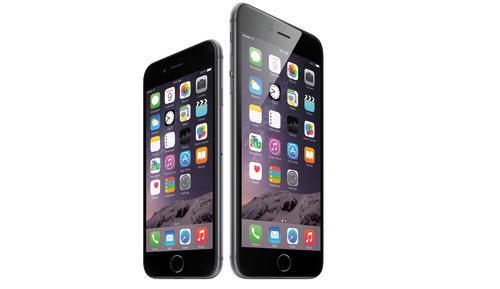
(Apple)
Their real names are the iPhone 6 ($200 and up with two-year contract) and the iPhone 6 Plus ($300 and up with contract).
And yes, that’s the big news: They have bigger screens than any iPhone before them. Steve Jobs used to mock Samsung’s increasingly jumbo smartphones, calling them “Hummers.” But apparently big is what the public wants. So big is what we get.
Here they are: the new iPhones, posed next to last year’s model, so you can get an idea of the scale:
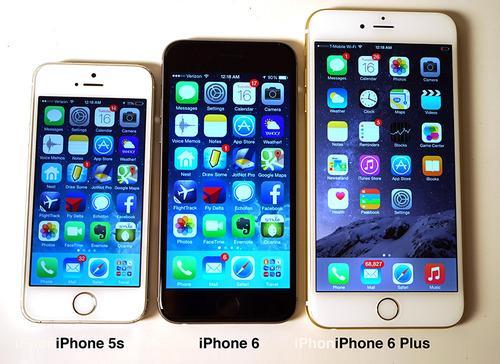
And here, for your reference, are the new iPhones among their Android rivals:
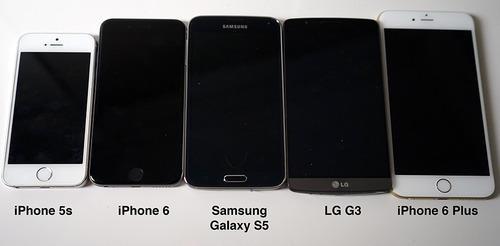
What’s wild is that at first, the iPhone 6 doesn’t seem bigger than the iPhone 5. The first thing most people say when they pick it up is, “It doesn’t seem that big!” You have to hold an iPhone 5s next to it before you really notice.
Part of the explanation may be the Apple diet: These new phones are thin. About a quarter of an inch. Thinner than their rivals from Samsung, HTC, or LG. If you order one online, FedEx will probably slip it under your door.
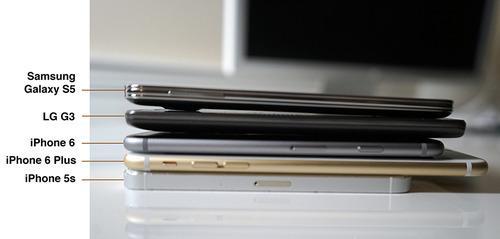
The aluminum body has smooth, rounded edges — a more comfortable shape than the sharpened corners of the iPhone 4 and 5 era. The ring around the camera lens on the back protrudes about a millimeter; it’s no longer perfectly flush.
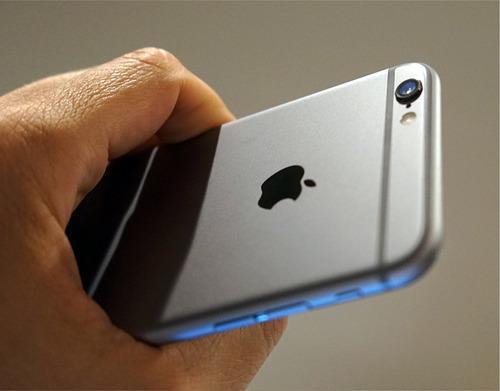
The screens are terrific. The smaller iPhone 6’s screen has 1334 × 750 pixels (326 dots per inch), and the Plus’s screen is 1920 × 1080 pixels (401 dpi), which is full high definition. Other phones have more dots or smaller ones, but at this point, everybody is just chasing unicorns; these screens have long since exceeded the ability of our eyes to distinguish pixels.
What to do with more screenThere’s a downside to having a bigger screen: You have to carry around a bigger phone. The small of hand won’t be thrilled about the added width. The iPhone 6 Plus, in particular, is a pocket-filler.
Apple is clearly aware of the drawbacks of gigantism. It has made some tweaks to make the size less awkward. The power/sleep button, for example, is on the side now instead of the top, so your thumb can reach it. (That’s a problem for people who use a volume key on the opposite edge as the camera shutter. Now when you grip the phone for photography, your thumb naturally falls on the sleep switch — and turns it off!)
The plus-sized 6 Plus, in fact, is well on its way to becoming an iPad Nano. As on an iPad, many of its built-in apps sprout extra panes when you turn the phone 90 degrees — like Mail and Calendar, for example:

Even the home screen rotates now, for the first time in iPhone history. (Some of Apple’s own apps rotate this way only on the 6 Plus, not the 6. Other software companies’ apps may rotate on both.)
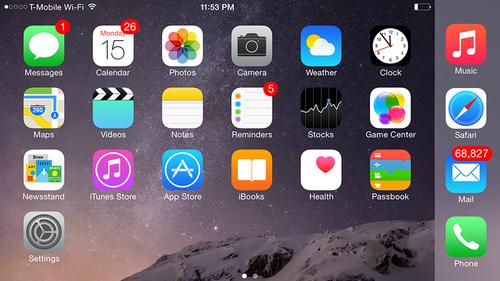
Also on the Plus: When you’re typing in landscape mode, there’s so much extra space that Apple has thrown in some additional on-screen keys. On the left: buttons for Cut, Copy, Paste, Bold, and Undo. On the right: Punctuation keys and actual cursor keys—a first on the iPhone.

On both phones, if there’s something at the top of the screen, too far away for your shrimpy little thumb to reach, you can touch the home button twice (touch, not click) to make the screen image slide down so you can reach what was at the top.
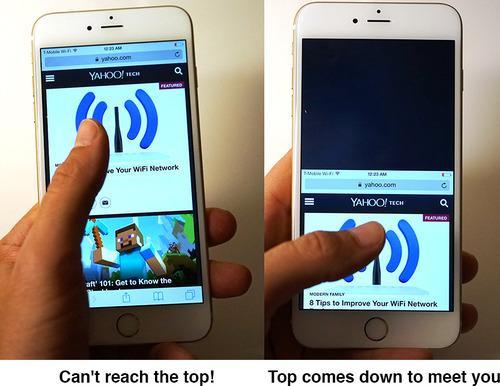
With this larger phone now usable one-handed, what do you really get for all that size? There are some huge advantages to having a huge phone. The obvious one, of course, is more screen. Both models are much better for reading ebooks, answering email, watching movies, surfing the Web, and so on. The iPhone 6 Plus may look a little goofy when you hold it to your ear to make phone calls, especially if you’re small of head, but, wow, is it luxurious when you’re trying to consult a map.
A less-obvious advantage to huge is compensating for over-40 eyes. In Settings, you can specify whether you want your phone to show more, or to show the same thing bigger. Here’s the effect:
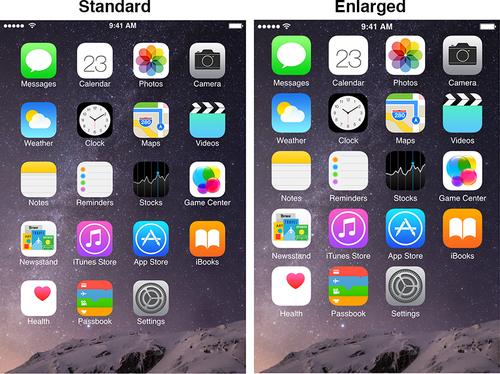
Apple has moved the Adjust Type Size (and Bold Text) controls out of the buried Settings panel where they used to be. They’re now front and center on the Display Preferences screen.
The upshot: With some Settings tweaks, these phones can be godsends for anyone who puts on reading glasses to check her phone.
The gutsInside, Apple has been up to its usual tightening and polishing. There’s a new chip inside that Apple says is 25 percent faster. You wouldn’t notice it without testing the old and new phones side by side. Apps, for example, pop open about a half-second faster on the new phone.
Apple says that the radio circuitry inside can tune into 20 bands of LTE (fast cellular Internet), which means that this phone works on the high-speed Internet networks of many more countries than its rivals. (The Samsung Galaxy S5, for example, gets six bands of LTE.) That’s a perk only if you travel overseas, of course.
A bigger phone means there’s room for a bigger battery. The iPhone 6 gets slightly better battery life — 14 hours of reported talk time, up from 10; 11 hours of Web surfing on WiFi, up from 10. The iPhone 6 Plus gets substantially better life: 24 hours of talk time, 12 hours of browsing, and so on. You’ll still have to charge the iPhone 6 daily, but the iPhone 6 Plus might actually make it two days on a charge.
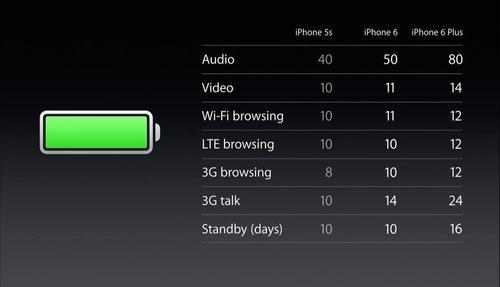
The new iPhones still don’t have removable memory cards. But at least you can buy them with more storage than before: They come in 16-, 64-, and, now, 128-gigabyte versions. That’s a heck of a lot of text messages and photos, although it’s weird that the sweet spot — 32 gigabytes — isn’t in the lineup.
The cellular circuitry offers some really cool refinements, although you won’t see the benefits for a while. The iPhone 6 is among the first VoLTE phones (pronounced “VOLty”). It stands for “voice over LTE,” and it means super-clear, rich sound quality — like FM instead of AM — when you’re calling another VoLTE phone.
Unfortunately, VoLTE does nothing for you unless your cellphone carrier has upgraded its network. So far, only T-Mobile has done that nationwide. The other carriers are still experimenting.
The iPhone 6 can also place calls over WiFi. You call people the same way, but you get to use your indoor WiFi router, and you don’t use up any cellular minutes. In fact, if you start a call in WiFi and then walk outside into a cellular LTE area, you don’t even drop the call. To make this work, I had to change two settings in Settings and restart the phone — but it finally did work, and beautifully. These features, too, work only on T-Mobile at the moment.
Apple PayTwo years ago, I sought out a 7-Eleven near my house because it had a contactless payment terminal on its cash register:
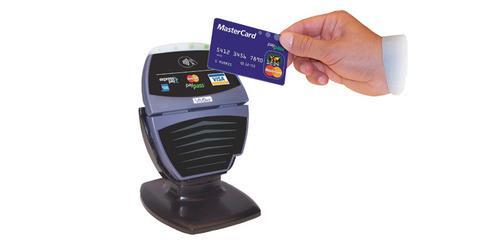
I was testing Google Wallet, a feature of some Android phones that lets you pay for things without even pulling out your wallet; you could just hold the phone near that terminal thing. But it took a lot of steps, including tapping in a security code with every purchase.
I recently visited the same 7-Eleven. You know what the guy told me? That the last person he remembered using his contactless terminal was me, two years ago.
Almost nobody pays by phone-tapping in this country, probably because it’s slower and clunkier than just swiping your credit card.
Apple Pay, new in the iPhone 6, will be different, Apple says.
The iPhone 6 models have an NFC chip inside (near-field communications), just like Android phones. That makes them work on those same contactless terminals, of which there are 220,000 across the United States. But you won’t have to turn on your iPhone, open an app, or fool around with credit cards. You just hold your phone (screen still asleep) near the terminal with your finger on the Home button. The screen lights up, shows your preferred credit card, sends you a receipt, and the deal is done.
The Home button, of course, is also a fingerprint reader; no bad guy can steal your phone and then start buying stuff, unless he also chops off your thumb. There’s more security stuff, too; you can read about it here.
Nobody can try out Apple Pay yet, though, because Apple won’t be turning it on until October; at that point, we’ll get an iOS 8 software update that includes Apple Pay features. (One important one: You’ll be able to store your credit card details in the Passbook app just by taking a picture of your physical cards — no typing.)
CameraThe iPhone camera is getting scarily good. Here are a few samples:
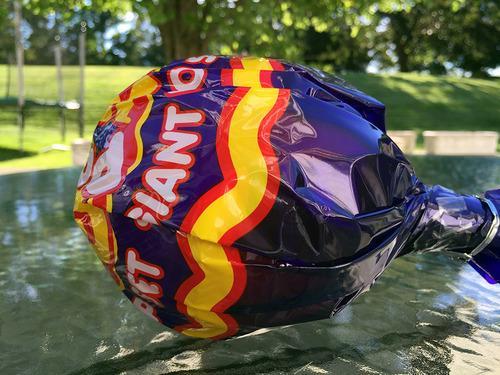


There’s now ultra-smooth, ultra-slow motion video (see the watermelon-smashing test in my video, above). There’s phase-detection autofocusing, which compares incoming light from two pixels for fast, precise focusing — or quick, smooth refocusing while recording video (hallelujah!).
The Plus model has optical image stabilization — the lens jiggles in precise motion to counteract the handheld movement of the phone itself — that works supremely well. To test it out, I fastened an iPhone 6 Plus and an iPhone 5s to a bike on this rig so that they would film exactly the same thing:
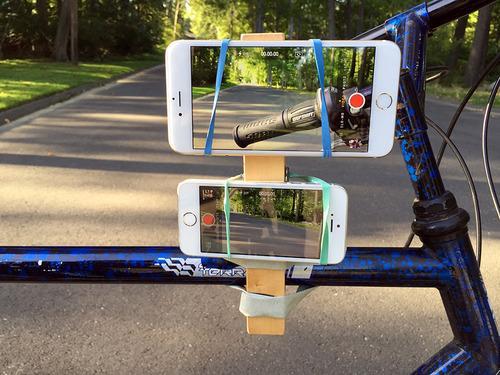
Then I rode around rough roads, filming. In my video above, you can see the side-by-side comparison of the two phones’ stabilization.
Free features for allSome of the iPhone 6’s features — design, screen, camera — are truly stunning. But you don’t have to ditch your old phone to get all of them.
That’s because tomorrow you’ll be able to download the newest Apple software for iPhones, iOS 8. Free.
You’ll be reading a lot more about iOS 8 here on Yahoo Tech, but trust me: Its ratio of useful features to glitzy ones is the highest in years. You won’t find many big-ticket items changed, but you will find loads of truly ingenious touch-ups that make phone life easier and less stressful.
A few of my favorites:
• When you tap the Add Photo button (to send a picture as a text message), you don’t have to burrow into your Photos collection; the last few photos you took present themselves immediately. Apple assumes that often, the photo you want to send is one of the most recent. (It’s correct.)

• You can use the fingerprint reader (iPhone 5s and 6 models) to do more than unlock the phone now. You can use it to log in to apps instead of remembering a password.
• There’s a Hyperlapse-style time-lapse video option.
• The keyboard is much better. Now you see the three words you’re most likely to type next, hovering just above the onscreen keyboard. (The video above shows it in action.)
• You gain the option to install other companies’ keyboards, like the popular Swype and SwiftKey keyboards.
• Siri’s command recognition (“Set my alarm”) has always been good, but now its dictation skills have been polished to a shine. It’s much, much more accurate — especially if you have an accent — and you see the words as you’re speaking them now.
• You can turn on hands-free, “always listening” mode for Siri whenever the phone is charging (for example, in the car). That is, even if it’s asleep, you can say, “Hey Siri” to make it listen to your next command.
A word to the armies of the faithful The iPhone 6 and iPhone 6 Plus are absolutely terrific phones. They’re fast and powerful and well designed. There’s not a single component that hasn’t been improved. These phones are a delight to behold and to be held.
But before we part, here’s a question that’s been the elephant in this room for years: If the iPhone is fantastic, does that mean that your phone is no good?
You will hear, for example — and it’s true — that Apple did not pioneer many of the iPhone 6’s big-ticket features. Other companies’ phones were first to introduce bigger phone screens; “always listening” voice commands; wireless payments; predictive keyboard words; phase-detection autofocusing; time-lapse video; optical image stabilizers; VoLTE calling; and so on.
That’s right: Apple has adapted features that first appeared on Android. Just as Google has adapted many features from Apple.
Why does it matter so much? If Apple is praised for doing good work, why does it so enrage Android fans — and vice versa?
The answer, of course, is that cellphones are deeply personal. When you buy a phone, you’re making an expensive bet. You can’t easily switch between the Google and Apple worlds; you’ve invested a lot in accessories, you’ve bought apps, you’ve learned that company’s software conventions. And you never want to think your phone is inferior, because then you might feel inferior.
So you wind up taking a side in this phone duopoly. You join a very silly — and unwinnable — religious war.
Judge the iPhone not just for what it is, but for the entire world that Apple has built around it: the apps, the music/movie/TV store, the integration with the Mac and iPad, the built-in online services. Does Apple generally do an excellent job with all of this? Yes.
Judge your Android phone the same way. Does it have a huge, open, lively world of apps and community online? Does it have a well-stocked movie/music/TV store? Is most of it well designed — and free? Yes.
Celebrate the iPhone’s excellence, even if you’re not in the Apple fold. And celebrate the best work of Samsung, HTC, and LG, even if you’re not part of the Android family.
Because, in the end, competition is what will make your phone better this time next year, or the year after that. The perpetual refinement of ideas, and the necessity to think up new ones, will benefit you — no matter which army you march with.
Tuesday, September 16, 2014
Landmark Fracking Study
The final report from a landmark federal study on hydraulic fracturing, or fracking, found no evidence that chemicals or brine water from the gas drilling process moved upward to contaminate drinking water at a site in western Pennsylvania.
The Department of Energy report, released Monday, was the first time an energy company allowed independent monitoring of a drilling site during the fracking process and for 18 months afterward. After those months of monitoring, researchers found that the chemical-laced fluids used to free gas stayed about 5,000 feet below drinking water supplies.
Scientists used tracer fluids, seismic monitoring, and other tests to look for problems, and created the most detailed public report to date about how fracking affects adjacent rock structures.
The fracking process uses millions of gallons of high-pressure water mixed with sand and chemicals to break apart rocks rich in oil and gas. That has led to a national boom in production, but also concerns about possible groundwater contamination.
But the DOE report is far from the last word on the subject. The Energy Department monitored six wells at one site, but oil or gas drilling at other locations around the nation could show different results because of variations in geology or drilling practices. Environmentalists and regulators have also documented numerous cases where surface spills of chemicals or wastewater damaged drinking water supplies.
"There are a whole wealth of harms associated with shale gas development" separate from fracking, said Maya K. van Rossum of the Delaware Riverkeeper group. She mentioned methane gas leaks, wasteful use of fresh water, and air pollution, and said the DOE study confirms a point that the Riverkeeper has been making: that faulty well construction is the root cause of most problems, not natural geologic migration of chemicals.
A separate study published this week by different researchers examined drilling sites in Pennsylvania and Texas using other methods. It found that faulty well construction caused pollution, but not fracking itself.
Avner Vengosh, a Duke University scientist involved with that study, just published in The Proceedings of the National Academy of Sciences, said in an email that it appears the Energy Department report on the Pennsylvania site is consistent with their findings.
The leading industry group in Pennsylvania said the DOE study reaffirms that hydraulic fracturing "is a safe and well-regulated technology." Marcellus Shale Coalition president Dave Spigelmyer said in an email that the study reflects "the industry's long and clear record of continuously working to enhance regulations and best practices aimed at protecting our environment."
The Energy Department report did yield some surprises. It found that the fractures created to free oil or gas can extend up to 1,900 feet from the base of the well. That's much farther than the usual estimates of a few hundred feet. The Energy Department researchers believe that the long fractures may have followed existing fault lines in the Marcellus Shale or other formations above it.
The DOE study also ran into problems with the man-made markers meant to track possible long-term pollution. DOE said it was able to track the markers for two months after fracking, but then that method had to be abandoned when it stopped working properly.
The Department of Energy report, released Monday, was the first time an energy company allowed independent monitoring of a drilling site during the fracking process and for 18 months afterward. After those months of monitoring, researchers found that the chemical-laced fluids used to free gas stayed about 5,000 feet below drinking water supplies.
Scientists used tracer fluids, seismic monitoring, and other tests to look for problems, and created the most detailed public report to date about how fracking affects adjacent rock structures.
The fracking process uses millions of gallons of high-pressure water mixed with sand and chemicals to break apart rocks rich in oil and gas. That has led to a national boom in production, but also concerns about possible groundwater contamination.
But the DOE report is far from the last word on the subject. The Energy Department monitored six wells at one site, but oil or gas drilling at other locations around the nation could show different results because of variations in geology or drilling practices. Environmentalists and regulators have also documented numerous cases where surface spills of chemicals or wastewater damaged drinking water supplies.
"There are a whole wealth of harms associated with shale gas development" separate from fracking, said Maya K. van Rossum of the Delaware Riverkeeper group. She mentioned methane gas leaks, wasteful use of fresh water, and air pollution, and said the DOE study confirms a point that the Riverkeeper has been making: that faulty well construction is the root cause of most problems, not natural geologic migration of chemicals.
A separate study published this week by different researchers examined drilling sites in Pennsylvania and Texas using other methods. It found that faulty well construction caused pollution, but not fracking itself.
Avner Vengosh, a Duke University scientist involved with that study, just published in The Proceedings of the National Academy of Sciences, said in an email that it appears the Energy Department report on the Pennsylvania site is consistent with their findings.
The leading industry group in Pennsylvania said the DOE study reaffirms that hydraulic fracturing "is a safe and well-regulated technology." Marcellus Shale Coalition president Dave Spigelmyer said in an email that the study reflects "the industry's long and clear record of continuously working to enhance regulations and best practices aimed at protecting our environment."
The Energy Department report did yield some surprises. It found that the fractures created to free oil or gas can extend up to 1,900 feet from the base of the well. That's much farther than the usual estimates of a few hundred feet. The Energy Department researchers believe that the long fractures may have followed existing fault lines in the Marcellus Shale or other formations above it.
The DOE study also ran into problems with the man-made markers meant to track possible long-term pollution. DOE said it was able to track the markers for two months after fracking, but then that method had to be abandoned when it stopped working properly.
A win for boeing or Elon Musk???
A big deal with NASA may be on the horizon for Boeing.
The Wall Street Journal is reporting that the Chicago-based aerospace giant will likely win a multibillion-dollar contract from NASA to build "space taxis.” A space taxi ferries astronauts to and from orbit and the international space station. NASA has set a deadline to announce the award this month.
A deal with Boeing (BA) would be a blow to Elon Musk's Space Exploration Technologies Corp., better known as Space-X. Space-X has been considered Boeing’s biggest competitor for the contract. Musk's company previously inked a deal with NASA to take equipment to the international space station.
But Yahoo Finance’s Rick Newman says Space-X likely will not walk away empty-handed if Boeing is awarded the contract. That’s because NASA needs a healthy private space industry. “The idea here is get two or three firms competing for these contracts,” he says, “And get all enough business to keep them going.” Newman believes that if Musk’s firm Space-X doesn’t win this deal, it will, “probably get sort of a consolation prize of a secondary contract.”
Space-X isn’t the only company vying for the contract. Sierra Nevada, a privately-held company that has partipated in more than 70 previous NASA programs, is also in the running for the funding. A joint award is also possible.
The company awarded the contract would build, operate and maintain a fleet of space taxis which will replace NASA’s old fleet of space shuttles. The space shuttle fleet was retired in 2011.
NASA currently relies on Russian rockets to fly U.S. astronauts to and from the international space station. U.S. officials and policymakers are concerned about the reliance on the Russians to maintain such a large portion of the NASA’s space program. Yahoo Finance’s Newman says it is difficult for the Obama admistration to put sanctions on Russia, and at the same time trust that this relationship can contiunue because, “They could pull the plug on it” at any time.
Relying on the Russians isn’t cheap either. The cost to transport a U.S. astronaut to the space station has ballooned to $70 million per seat.
Officials hope to end the rocket ride-sharing program with Russia by 2017. According to the WSJ report, space industry experts as well as government insiders say Boeing’s bid has emerged as the frontrunner because it is “the least risky option” and would most likely be ready for flight in the next three years.
NASA chief Charles Bolden could overrule any decision
The Wall Street Journal is reporting that the Chicago-based aerospace giant will likely win a multibillion-dollar contract from NASA to build "space taxis.” A space taxi ferries astronauts to and from orbit and the international space station. NASA has set a deadline to announce the award this month.
A deal with Boeing (BA) would be a blow to Elon Musk's Space Exploration Technologies Corp., better known as Space-X. Space-X has been considered Boeing’s biggest competitor for the contract. Musk's company previously inked a deal with NASA to take equipment to the international space station.
But Yahoo Finance’s Rick Newman says Space-X likely will not walk away empty-handed if Boeing is awarded the contract. That’s because NASA needs a healthy private space industry. “The idea here is get two or three firms competing for these contracts,” he says, “And get all enough business to keep them going.” Newman believes that if Musk’s firm Space-X doesn’t win this deal, it will, “probably get sort of a consolation prize of a secondary contract.”
Space-X isn’t the only company vying for the contract. Sierra Nevada, a privately-held company that has partipated in more than 70 previous NASA programs, is also in the running for the funding. A joint award is also possible.
The company awarded the contract would build, operate and maintain a fleet of space taxis which will replace NASA’s old fleet of space shuttles. The space shuttle fleet was retired in 2011.
NASA currently relies on Russian rockets to fly U.S. astronauts to and from the international space station. U.S. officials and policymakers are concerned about the reliance on the Russians to maintain such a large portion of the NASA’s space program. Yahoo Finance’s Newman says it is difficult for the Obama admistration to put sanctions on Russia, and at the same time trust that this relationship can contiunue because, “They could pull the plug on it” at any time.
Relying on the Russians isn’t cheap either. The cost to transport a U.S. astronaut to the space station has ballooned to $70 million per seat.
Officials hope to end the rocket ride-sharing program with Russia by 2017. According to the WSJ report, space industry experts as well as government insiders say Boeing’s bid has emerged as the frontrunner because it is “the least risky option” and would most likely be ready for flight in the next three years.
NASA chief Charles Bolden could overrule any decision
Monday, September 15, 2014
Tesla Getting killed---heres why
Tesla Motors (TSLA) stock dropped Monday after Morgan Stanley suggested that its shares had risen for the wrong reasons.
Shares in the electric car maker fell more than 9 percent by Monday afternoon, after Morgan Stanley researchers posited that they "do not expect the stock to appreciate so consistently and one-directionally from here."
One of the major concerns that the analysts noted is the failure of other electric vehicles across the developed world, which could lead to the industry to lobby for a "substantial revision" of air quality regulations "to slow down the pace of milestones they have little hope of achieving (besides Tesla)."
Morgan Stanley analysts also wrote that Tesla may have difficulty keeping up with Chinese demand, and that the eventual switch to autonomous vehicles may negate Tesla's current strategic advantages.
Still, the analysts said that Tesla's shares are ultimately worth $320, despite perhaps moving toward that target too quickly.
Last week, Tesla CEO Elon Musk suggested that investors often "get carried away" with his stock price.
Read More Tesla sinks after Musk's 'kind of high' comment
"I think our stock price is kind of high right now," Musk said last week, responding to a question from CNBC at a news conference. "If you care about the long term, Tesla, I think the stock is a good price. If you look at the short term, it is less clear."
Shares in the electric car maker fell more than 9 percent by Monday afternoon, after Morgan Stanley researchers posited that they "do not expect the stock to appreciate so consistently and one-directionally from here."
One of the major concerns that the analysts noted is the failure of other electric vehicles across the developed world, which could lead to the industry to lobby for a "substantial revision" of air quality regulations "to slow down the pace of milestones they have little hope of achieving (besides Tesla)."
Morgan Stanley analysts also wrote that Tesla may have difficulty keeping up with Chinese demand, and that the eventual switch to autonomous vehicles may negate Tesla's current strategic advantages.
Still, the analysts said that Tesla's shares are ultimately worth $320, despite perhaps moving toward that target too quickly.
Last week, Tesla CEO Elon Musk suggested that investors often "get carried away" with his stock price.
Read More Tesla sinks after Musk's 'kind of high' comment
"I think our stock price is kind of high right now," Musk said last week, responding to a question from CNBC at a news conference. "If you care about the long term, Tesla, I think the stock is a good price. If you look at the short term, it is less clear."
Recent Analyst upgrades
Ambarella (NASDAQ:AMBA) was upgraded by analysts at Zacks from a neutral rating to an outperform rating. Zacks currently has $40.90 price target on the stock.
Carmike Cinemas (NASDAQ:CKEC) was upgraded by analysts at Zacks from an underperform rating to a neutral rating. The firm currently has $33.90 price target on the stock.
Coca-Cola Bottling Co. Consolidated (NASDAQ:COKE) was upgraded by analysts at TheStreet to a buy rating.
Cypress Semiconductor (NYSE:CY) was upgraded by analysts at Zacks from a neutral rating to an outperform rating. They currently have $13.00 price target on the stock. Zacks’ analyst wrote, “Cypress develops and manufactures a broad range of digital and mixed signal ICs. The company’s second-quarter earnings were higher than the Zacks Consensus Estimate driven by solid expense management and higher gross margins. An improving mix, cost control and robust demand also resulted in a better-than-expected forward guidance. Though an uncertain macro environment and increased pricing pressure remain concerns, we are encouraged about the company’s advanced technology, momentum in new products, increased customer wins and growth initiatives. We are therefore upgrading Cypress shares to Outperform .”
Fidelity National Financial (NYSE:FNF) was upgraded by analysts at Zacks from an underperform rating to a neutral rating. Zacks currently has $28.50 target price on the stock.
Gigamon (NASDAQ:GIMO) was upgraded by analysts at Zacks from an underperform rating to a neutral rating. Zacks currently has $11.20 target price on the stock.
China Lodging Group, Ltd (NASDAQ:HTHT) was upgraded by analysts at Zacks from a neutral rating to an outperform rating. They currently have $28.80 price target on the stock.
Javelin Mortgage Investment Corp (NYSE:JMI) was upgraded by analysts at Zacks from an underperform rating to a neutral rating. The firm currently has $13.60 price target on the stock.
L Brands (NYSE:LB) was upgraded by analysts at TheStreet to a buy rating.
Lumber Liquidators Holdings (NYSE:LL) was upgraded by analysts at Zacks from an underperform rating to a neutral rating. They currently have $58.00 target price on the stock.
Micronet Enertec Technologies (NASDAQ:MICT) was upgraded by analysts at Aegis from a hold rating to a buy rating.
Primero Mining Corp (NYSE:PPP) was upgraded by analysts at Zacks from an underperform rating to a neutral rating. They currently have $6.10 target price on the stock.
PrivateBancorp (NASDAQ:PVTB) was upgraded by analysts at Zacks from a neutral rating to an outperform rating. Zacks currently has $32.00 price target on the stock.
Rofin-Sinar Technologies (NASDAQ:RSTI) was upgraded by analysts at Zacks from an underperform rating to a neutral rating. They currently have $23.80 target price on the stock.
Scientific Games Corp (NASDAQ:SGMS) was upgraded by analysts at Zacks from an underperform rating to a neutral rating. They currently have $14.00 price target on the stock. Zacks’ analyst wrote, “Scientific Games reported dismal second-quarter 2014 results, with a wider year over year loss. However, revenues were inline with the Zacks Consensus Estimate. The sluggish macroeconomic environment is expected to persist for the remaining of FY14, which will hurt company’s results. We believe that the expanded product portfolio that resulted from the acquisitions of WMS and Bally Technologies will boost top line growth. Moreover, acquisition of Bally Technologies will lower competition, thereby expanding its market share. However, we believe that the acquisition will put its balance sheet under further pressure as the company has opted for debt-financing. Moreover, pricing pressure due to slow demand and stiff competition remains a concern. Nevertheless, we believe that the back-to-back acquisitions of WMS and Bally Technologies improves Scientific Games overall growth prospect over the long term. Thus, we upgrade our recommendation from Underperform to Neutral and set a price target of $14.00. “
Carmike Cinemas (NASDAQ:CKEC) was upgraded by analysts at Zacks from an underperform rating to a neutral rating. The firm currently has $33.90 price target on the stock.
Coca-Cola Bottling Co. Consolidated (NASDAQ:COKE) was upgraded by analysts at TheStreet to a buy rating.
Cypress Semiconductor (NYSE:CY) was upgraded by analysts at Zacks from a neutral rating to an outperform rating. They currently have $13.00 price target on the stock. Zacks’ analyst wrote, “Cypress develops and manufactures a broad range of digital and mixed signal ICs. The company’s second-quarter earnings were higher than the Zacks Consensus Estimate driven by solid expense management and higher gross margins. An improving mix, cost control and robust demand also resulted in a better-than-expected forward guidance. Though an uncertain macro environment and increased pricing pressure remain concerns, we are encouraged about the company’s advanced technology, momentum in new products, increased customer wins and growth initiatives. We are therefore upgrading Cypress shares to Outperform .”
Fidelity National Financial (NYSE:FNF) was upgraded by analysts at Zacks from an underperform rating to a neutral rating. Zacks currently has $28.50 target price on the stock.
Gigamon (NASDAQ:GIMO) was upgraded by analysts at Zacks from an underperform rating to a neutral rating. Zacks currently has $11.20 target price on the stock.
China Lodging Group, Ltd (NASDAQ:HTHT) was upgraded by analysts at Zacks from a neutral rating to an outperform rating. They currently have $28.80 price target on the stock.
Javelin Mortgage Investment Corp (NYSE:JMI) was upgraded by analysts at Zacks from an underperform rating to a neutral rating. The firm currently has $13.60 price target on the stock.
L Brands (NYSE:LB) was upgraded by analysts at TheStreet to a buy rating.
Lumber Liquidators Holdings (NYSE:LL) was upgraded by analysts at Zacks from an underperform rating to a neutral rating. They currently have $58.00 target price on the stock.
Micronet Enertec Technologies (NASDAQ:MICT) was upgraded by analysts at Aegis from a hold rating to a buy rating.
Primero Mining Corp (NYSE:PPP) was upgraded by analysts at Zacks from an underperform rating to a neutral rating. They currently have $6.10 target price on the stock.
PrivateBancorp (NASDAQ:PVTB) was upgraded by analysts at Zacks from a neutral rating to an outperform rating. Zacks currently has $32.00 price target on the stock.
Rofin-Sinar Technologies (NASDAQ:RSTI) was upgraded by analysts at Zacks from an underperform rating to a neutral rating. They currently have $23.80 target price on the stock.
Scientific Games Corp (NASDAQ:SGMS) was upgraded by analysts at Zacks from an underperform rating to a neutral rating. They currently have $14.00 price target on the stock. Zacks’ analyst wrote, “Scientific Games reported dismal second-quarter 2014 results, with a wider year over year loss. However, revenues were inline with the Zacks Consensus Estimate. The sluggish macroeconomic environment is expected to persist for the remaining of FY14, which will hurt company’s results. We believe that the expanded product portfolio that resulted from the acquisitions of WMS and Bally Technologies will boost top line growth. Moreover, acquisition of Bally Technologies will lower competition, thereby expanding its market share. However, we believe that the acquisition will put its balance sheet under further pressure as the company has opted for debt-financing. Moreover, pricing pressure due to slow demand and stiff competition remains a concern. Nevertheless, we believe that the back-to-back acquisitions of WMS and Bally Technologies improves Scientific Games overall growth prospect over the long term. Thus, we upgrade our recommendation from Underperform to Neutral and set a price target of $14.00. “
Apple iPhone 6 Supply issues
Apple says it had more than 4 million pre-orders of its new iPhone 6 and iPhone 6 Plus in 24 hours, exceeding its initial pre-order supply.
The company says the phones will be delivered to customers starting Friday and throughout September, but many won't be delivered until October.
Phones will be available on a walk-in basis beginning Friday at Apple retail stores. Both phones will also be available beginning Friday from AT&T, Sprint, T-Mobile, Verizon Wireless and other carriers and other authorized Apple resellers.
The new phones were announced last week and have larger screens, faster performance, and come equipped with Apple Pay, a contactless payment service. They start at $199 at most wireless providers with a two-year contact
Friday, September 12, 2014
ICYMI Newmont Mining SELLS huge asset
Newmont Mining (NYSE:NEM) just announced another sale to raise cash and strengthen its asset base. This time, the company has entered into a binding purchase and sale agreement with Fresnillo plc (OTCPK:FNLPF) to sell its entire 44 percent stake in the Penmont joint venture in Mexico. This will raise even more cash for Newmont to help focus on its producing mines and ensure cash flows to pay dividends and really focus on improving profitable sites. This deal is for approximately $477 million, which will yield cash proceeds of $450 million for Newmont at closing. As Newmont is selling its entire stake......>READ FULL ARTICLE
Hecla strikes gold....errrr...Silver :)
Hecla Mining (NYSE:HL) just announced results from its exploration drilling program on the North and Middle Veins at its San Sebastian property in Durango, Mexico. What is important to remember is that over the last year, the focus of the drilling program has been on targets close to the surface of the Middle and North Veins. The two veins are parallel and located 140 meters apart. The Middle Vein has been intersected by 197 holes and 38 surface trenches and can be traced for nearly two kilometers along strike and to a depth of over 300 meters. The big takeaway is that the upper portion of the Middle Vein contains high-grade mineralization close to the surface that may be suitable to open pit mining. Drill results in the second and third quarters were extremely positive and....READ FULL ARTICLE
Wednesday, September 10, 2014
Walmart a key player in Family Dollar/Dollar General Drama
After an earlier offer for Family Dollar was rejected because of antitrust concerns, Dollar General increased its price to $80 a share in cash. Along with the sweetened bid, it pledged to divest as many as 1,500 locations to placate regulators, up from 700 in its earlier offer. It also said it would pay Family Dollar $500 million if the deal failed to garner approval.
Wal-Mart Stores Inc. (WMT), the largest retail chain in total revenue, has served as a wild card in the saga. It’s pushing deeper into the market for neighborhood discount stores, potentially providing more competition within the industry. To get the deal past the Federal Trade Commission, Dollar General may have to establish that Wal-Mart and other retailers provide enough of a counterweight to a dominant dollar-store chain.
“We now can begin the antitrust review process and will have an opportunity to present our position directly to the FTC,” Dollar General CEO Rick Dreiling said today. “As we previously have stated, we are confident in the results of our antitrust analysis, and we look forward to a constructive dialogue with the FTC.”
Wal-Mart Stores Inc. (WMT), the largest retail chain in total revenue, has served as a wild card in the saga. It’s pushing deeper into the market for neighborhood discount stores, potentially providing more competition within the industry. To get the deal past the Federal Trade Commission, Dollar General may have to establish that Wal-Mart and other retailers provide enough of a counterweight to a dominant dollar-store chain.
“We now can begin the antitrust review process and will have an opportunity to present our position directly to the FTC,” Dollar General CEO Rick Dreiling said today. “As we previously have stated, we are confident in the results of our antitrust analysis, and we look forward to a constructive dialogue with the FTC.”
Vera Bradley Earnings
Vera Bradley, Inc. (Nasdaq:VRA) ("Vera Bradley" or the "Company") today announced its financial results for the second quarter and six months ended August 2, 2014.
Net revenues totaled $120.1 million for the current year second quarter, compared to $125.4 million in the prior year second quarter ended August 3, 2013. Net income totaled $7.6 million, or $0.19 per diluted share, for the current year second quarter compared to net income of $15.0 million, or $0.37 per diluted share, in the prior year second quarter.
For the six months ended August 2, 2014, net revenues totaled $233.6 million, compared to $248.4 million in the prior year six months ended August 3, 2013. Net income totaled $14.2 million, or $0.35 per diluted share, for the current year six month period compared to net income of $24.1 million, or $0.59 per diluted share, in the comparable prior year period.
Robert Wallstrom, Chief Executive Officer, noted, "We achieved our earnings per share guidance for the quarter and are reconfirming our EPS guidance for the full year. Second quarter sales were at the high end of our expectations, and, as a percent of sales, SG&A expenses were at the low end of our target."
"Even though the short-term continues to be challenging, I am very pleased with the progress we are making against our long-term product, distribution, and marketing strategies. We are evolving and modernizing our product assortments, expanding our reach through opening new full-line and factory outlet stores, transitioning to a 'made-for-outlet' format in our factory outlet stores, enhancing our online presence, and intensifying and focusing our marketing efforts. We carefully managed our inventories and ended the quarter with a strong cash position and no debt. Importantly, we have assembled the talented and experienced leadership team that will drive the execution of our five-year strategic plan."
Second Quarter Results
Current year second quarter net revenues of $120.1 million were at the top end of the Company's guidance of $113 million to $120 million. Prior year second quarter revenues totaled $125.4 million.
Current year second quarter Direct segment revenues totaled $78.9 million, a 5.2% increase over $75.0 million in the prior year second quarter. In the Company's stores, second quarter year-over-year net revenues grew 3.5%, reflecting the opening of nine full-line and six outlet stores during the past 12 months, which was partially offset by a comparable store sales decline. Total company comparable sales fell 5.3% for the quarter (which includes a 14.2% decline in store sales, partially offset by a 9.3% increase in e-commerce sales, including direct-to-consumer eBay sales). Going forward, the Company will include eBay sales in its comparable sales calculations; refer to the attached schedule for historical comparable sales data adjusted to include eBay sales. Excluding eBay, total company comparable sales fell 8.8% for the quarter. As expected, second quarter comparable sales were negatively impacted by year-over-year declines in traffic and underperformance of the product offering.
Indirect segment revenues decreased 18.2% to $41.2 million from $50.4 million in the prior year second quarter, primarily due to lower orders from the Company's specialty retail accounts as well as a reduction in the number of specialty retail accounts.
Gross profit for the quarter totaled $64.1 million, or 53.3% of net revenues, compared to $71.8 million, or 57.2% of net revenues, in the prior year second quarter. The year-over-year decline in gross margin rate was primarily related to overhead costs deleveraging and modestly increased year-over-year online promotional activity. The second quarter gross margin rate was slightly below guidance of 53.5% to 54.0%, primarily due to a modest increase in online promotional activity.
SG&A expense totaled $51.8 million, or 43.1% of net revenues, in the current year second quarter, compared to $48.3 million, or 38.6% of net revenues, in the prior year second quarter. As expected, SG&A dollars increased over the prior year primarily due to investments related to achieving the five-year strategic plan including key management additions, new store expenses, and marketing and e-commerce initiatives. The SG&A expense rate was at the low end of the 43.0% to 44.5% guidance primarily due to cost containment efforts and sales at the high end of guidance.
Operating income totaled $12.8 million, or 10.6% of net revenues, in the current year second quarter, compared to operating income of $24.1 million, or 19.2% of net revenues, in the prior year second quarter.
The effective tax rate was 40.3% for the quarter compared to 37.7% in the prior year second quarter. The year-over-year increase in the effective rate was due primarily to state tax matters including an incremental reserve related to an ongoing state income tax audit.
Six Month Results
Current year net revenues for the six months totaled $233.6 million, compared to $248.4 million in the same period last year.
Direct segment revenues totaled $152.4 million for the six months ended August 2, 2014, a 2.5% increase over $148.7 million in the prior year comparable period. In the Company's stores, current year-over-year net revenues grew 4.5%, reflecting the opening of nine full-line and six outlet stores during the past 12 months, which was partially offset by a comparable store sales decline. Total company comparable sales fell 6.4% for the six months (which includes a 14.3% decline in store sales, partially offset by a 5.0% increase in e-commerce sales, including eBay). Excluding eBay sales, total company comparable sales fell 9.1% for the six months.
For the six months, Indirect segment revenues decreased 18.6% to $81.2 million from $99.7 million in the prior year, primarily due to lower orders from the Company's specialty retail accounts as well as a reduction in the number of specialty retail accounts.
Gross profit for the six months totaled $124.6 million, or 53.3% of net revenues, compared to $140.2 million, or 56.5% of net revenues, in the comparable prior year period. The year-over-year decline in gross margin rate was primarily related to overhead costs deleveraging and increased year-over-year promotional activity.
SG&A expense totaled $103.1 million, or 44.1% of net revenues, in the current year six months, compared to $103.6 million, or 41.7% of net revenues, in the prior year period.
Operating income totaled $23.6 million, or 10.1% of net revenues, in the current year six-month period, compared to operating income of $39.3 million, or 15.8% of net revenues, in the prior year period.
The effective tax rate was 39.6% for the six months compared to 38.2% in the prior year six months.
Cash flow from operations for the six months totaled $32.8 million, compared to $27.0 million for the same period last year. The improvement was driven primarily by a reduction in inventory levels.
Cash and cash equivalents as of August 2, 2014 totaled $79.1 million compared to $9.3 million at the end of last year's second quarter. The Company had no debt outstanding at August 2, 2014. Quarter-end inventory was $112.0 million, below guidance of $118 million to $128 million and compared to $142.9 million last year. Net capital spending for the six months totaled $12.2 million.
Recent Events
On June 4, 2014, the Company entered into a five-year agreement with Mitsubishi Corporation Fashion Company and Look Inc. to import and distribute Vera Bradley (VRA) products in Japan. As a result of moving to this wholesale business model, the Company will exit its direct business in Japan during the third quarter of fiscal 2015 and will account for this business as a discontinued operation from that point forward. The Company expects to incur pre-tax charges related to the exit from Japan during the third quarter of approximately $2.0 million, equating to $0.03 per share, which will be reflected in discontinued operations. Approximately $1.0 million of that amount relates to a non-cash charge for a currency translation loss that has accumulated in equity since entering the Japanese market over three years ago. The remaining charge relates to the write off of certain assets, employee severance, and other exit charges. The new wholesale business in Japan is included in the Indirect segment guidance below, but given that the new Look-operated distribution points are not expected to be opened until late in the year, the impact to the current year sales and earnings guidance is minimal.
On September 9, 2014, the Company's board of directors approved a share repurchase program authorizing up to $40 million in common stock repurchases. The new share repurchase program expires in October 2016.
Third Quarter and Fiscal Year 2015 Outlook
For the third quarter of fiscal 2015, on a continuing operations basis, the Company expects:
For fiscal 2015, on a continuing operations basis, the Company expects:
Net revenues totaled $120.1 million for the current year second quarter, compared to $125.4 million in the prior year second quarter ended August 3, 2013. Net income totaled $7.6 million, or $0.19 per diluted share, for the current year second quarter compared to net income of $15.0 million, or $0.37 per diluted share, in the prior year second quarter.
For the six months ended August 2, 2014, net revenues totaled $233.6 million, compared to $248.4 million in the prior year six months ended August 3, 2013. Net income totaled $14.2 million, or $0.35 per diluted share, for the current year six month period compared to net income of $24.1 million, or $0.59 per diluted share, in the comparable prior year period.
Robert Wallstrom, Chief Executive Officer, noted, "We achieved our earnings per share guidance for the quarter and are reconfirming our EPS guidance for the full year. Second quarter sales were at the high end of our expectations, and, as a percent of sales, SG&A expenses were at the low end of our target."
"Even though the short-term continues to be challenging, I am very pleased with the progress we are making against our long-term product, distribution, and marketing strategies. We are evolving and modernizing our product assortments, expanding our reach through opening new full-line and factory outlet stores, transitioning to a 'made-for-outlet' format in our factory outlet stores, enhancing our online presence, and intensifying and focusing our marketing efforts. We carefully managed our inventories and ended the quarter with a strong cash position and no debt. Importantly, we have assembled the talented and experienced leadership team that will drive the execution of our five-year strategic plan."
Second Quarter Results
Current year second quarter net revenues of $120.1 million were at the top end of the Company's guidance of $113 million to $120 million. Prior year second quarter revenues totaled $125.4 million.
Current year second quarter Direct segment revenues totaled $78.9 million, a 5.2% increase over $75.0 million in the prior year second quarter. In the Company's stores, second quarter year-over-year net revenues grew 3.5%, reflecting the opening of nine full-line and six outlet stores during the past 12 months, which was partially offset by a comparable store sales decline. Total company comparable sales fell 5.3% for the quarter (which includes a 14.2% decline in store sales, partially offset by a 9.3% increase in e-commerce sales, including direct-to-consumer eBay sales). Going forward, the Company will include eBay sales in its comparable sales calculations; refer to the attached schedule for historical comparable sales data adjusted to include eBay sales. Excluding eBay, total company comparable sales fell 8.8% for the quarter. As expected, second quarter comparable sales were negatively impacted by year-over-year declines in traffic and underperformance of the product offering.
Indirect segment revenues decreased 18.2% to $41.2 million from $50.4 million in the prior year second quarter, primarily due to lower orders from the Company's specialty retail accounts as well as a reduction in the number of specialty retail accounts.
Gross profit for the quarter totaled $64.1 million, or 53.3% of net revenues, compared to $71.8 million, or 57.2% of net revenues, in the prior year second quarter. The year-over-year decline in gross margin rate was primarily related to overhead costs deleveraging and modestly increased year-over-year online promotional activity. The second quarter gross margin rate was slightly below guidance of 53.5% to 54.0%, primarily due to a modest increase in online promotional activity.
SG&A expense totaled $51.8 million, or 43.1% of net revenues, in the current year second quarter, compared to $48.3 million, or 38.6% of net revenues, in the prior year second quarter. As expected, SG&A dollars increased over the prior year primarily due to investments related to achieving the five-year strategic plan including key management additions, new store expenses, and marketing and e-commerce initiatives. The SG&A expense rate was at the low end of the 43.0% to 44.5% guidance primarily due to cost containment efforts and sales at the high end of guidance.
Operating income totaled $12.8 million, or 10.6% of net revenues, in the current year second quarter, compared to operating income of $24.1 million, or 19.2% of net revenues, in the prior year second quarter.
The effective tax rate was 40.3% for the quarter compared to 37.7% in the prior year second quarter. The year-over-year increase in the effective rate was due primarily to state tax matters including an incremental reserve related to an ongoing state income tax audit.
Six Month Results
Current year net revenues for the six months totaled $233.6 million, compared to $248.4 million in the same period last year.
Direct segment revenues totaled $152.4 million for the six months ended August 2, 2014, a 2.5% increase over $148.7 million in the prior year comparable period. In the Company's stores, current year-over-year net revenues grew 4.5%, reflecting the opening of nine full-line and six outlet stores during the past 12 months, which was partially offset by a comparable store sales decline. Total company comparable sales fell 6.4% for the six months (which includes a 14.3% decline in store sales, partially offset by a 5.0% increase in e-commerce sales, including eBay). Excluding eBay sales, total company comparable sales fell 9.1% for the six months.
For the six months, Indirect segment revenues decreased 18.6% to $81.2 million from $99.7 million in the prior year, primarily due to lower orders from the Company's specialty retail accounts as well as a reduction in the number of specialty retail accounts.
Gross profit for the six months totaled $124.6 million, or 53.3% of net revenues, compared to $140.2 million, or 56.5% of net revenues, in the comparable prior year period. The year-over-year decline in gross margin rate was primarily related to overhead costs deleveraging and increased year-over-year promotional activity.
SG&A expense totaled $103.1 million, or 44.1% of net revenues, in the current year six months, compared to $103.6 million, or 41.7% of net revenues, in the prior year period.
Operating income totaled $23.6 million, or 10.1% of net revenues, in the current year six-month period, compared to operating income of $39.3 million, or 15.8% of net revenues, in the prior year period.
The effective tax rate was 39.6% for the six months compared to 38.2% in the prior year six months.
Cash flow from operations for the six months totaled $32.8 million, compared to $27.0 million for the same period last year. The improvement was driven primarily by a reduction in inventory levels.
Cash and cash equivalents as of August 2, 2014 totaled $79.1 million compared to $9.3 million at the end of last year's second quarter. The Company had no debt outstanding at August 2, 2014. Quarter-end inventory was $112.0 million, below guidance of $118 million to $128 million and compared to $142.9 million last year. Net capital spending for the six months totaled $12.2 million.
Recent Events
On June 4, 2014, the Company entered into a five-year agreement with Mitsubishi Corporation Fashion Company and Look Inc. to import and distribute Vera Bradley (VRA) products in Japan. As a result of moving to this wholesale business model, the Company will exit its direct business in Japan during the third quarter of fiscal 2015 and will account for this business as a discontinued operation from that point forward. The Company expects to incur pre-tax charges related to the exit from Japan during the third quarter of approximately $2.0 million, equating to $0.03 per share, which will be reflected in discontinued operations. Approximately $1.0 million of that amount relates to a non-cash charge for a currency translation loss that has accumulated in equity since entering the Japanese market over three years ago. The remaining charge relates to the write off of certain assets, employee severance, and other exit charges. The new wholesale business in Japan is included in the Indirect segment guidance below, but given that the new Look-operated distribution points are not expected to be opened until late in the year, the impact to the current year sales and earnings guidance is minimal.
On September 9, 2014, the Company's board of directors approved a share repurchase program authorizing up to $40 million in common stock repurchases. The new share repurchase program expires in October 2016.
Third Quarter and Fiscal Year 2015 Outlook
For the third quarter of fiscal 2015, on a continuing operations basis, the Company expects:
- Net revenues to be in the range of $123 million to $128 million compared to prior year third quarter revenues of $128.9 million.
- The gross margin rate to range from 52.0% to 53.0% compared to 55.2% in the prior year third quarter.
- SG&A as a percent of sales to range from 43.0% to 44.5% compared to 36.9% in the prior year third quarter.
- Diluted earnings per share from continuing operations to be in the range of $0.18 to $0.20, based on diluted weighted-average shares outstanding of 40.7 million and an effective tax rate of 36.5%. Diluted earnings per share from continuing operations totaled $0.39 in the prior year third quarter.
For fiscal 2015, on a continuing operations basis, the Company expects:
- Net revenues to be in the range of $520 million to $530 million compared to $530.9 million last year.
- The gross margin rate to range from 52.5% to 53.5% compared to 55.0% last year.
- SG&A as a percent of sales to range from 40.5% to 41.5% compared to 37.9% last year.
- Diluted earnings per share from continuing operations to be in the range of $1.00 to $1.10, based on diluted weighted-average shares outstanding of 40.7 million and an effective tax rate of 38.5%. Diluted earnings per share from continuing operations totaled $1.48 last year.
- Net capital spending of approximately $40 million.
IS Chuck E-Cheese worth the investment?
I recently visited my local Chuck-e-Cheese (NYSE:CEC) to help answer this question as I am considering an addition to my portfolio on the food entertainment industry. Major competitors are Dave and Busters, as well as general arcades and even McDonalds (NYSE:MCD) which offer play places. I recently interviewed the manager, who wished not to be named.
Me: "So in general would you say things are improving business wise?"
Manager: "Absolutely. We have seen steady increases in customer traffic, higher revenues for food as well as gaming. Our restructuring has begun to payoff"
Me: "What restructuring?"
Manager: "We have recently overhauled all of the gaming systems to include games that are friendly to all ages, and still only charge 25 cents a token. What is great is that the new machines require far less maintenance, and our store's maintenance budget is flush. Further, I have taken note of many repeat customers"
Me: "How about food costs?"
Manager: "While food costs are up, particularly for produce, our prices have increased as well. This has offset the increase in costs on our end".
Me: "What about quality"
Manager: "We use very high quality ingredients for nearly all of our products. The only thing that varies is our cheese suppliers. This can change the flavor of our pizza slightly but rarely is there a complaint"
Me: "In terms of your food prices, aren't there still very generous coupons that must offset income"
Manager: "Corporate does reimburse us, but for an investor like yourself, generous coupons are a catch-22. They bring folks in which is the main goal, but if they don't spend extra cash, the store can break even or take a loss in some cases. The good news is that our coupons are now less generous than before, but still enticing enough to bring customers in"
Me: "What would you say is the greatest revenue source?"
Manager: "Besides our games which require just electricity and routine maintenance, our birthday parties bring in about $10,000 in revenue per week to our store alone, sometimes even $20,000 which is much higher than it had been just two or three years ago".
Me: "Are there any large negatives to the business right now"
Manager: "Well im old fashioned. I did not like the revamp of the Chuck-e-Cheese character. I think the new character makes kids feel less comfortable with Chuck, but that's my opinion. In no way has it hurt sales. I would also add that our utility prices keep rising which takes a large part of our revenues, but for the most part, our store is more profitable than it has ever been"
Me: "Last question. Would you buy stock in the company?"
Manager: "I own some in a retirement account, but Im the wrong person to ask. I invite you to try our food, play some games and check out the selection. I think you will be pleased. Good luck with your article, your writing career and your business."
This visit occurred on September 8th. I must say I was impressed. The finances of the company are stronger than ever and the company even pays a dividend. Further, the company is running all new promotions. It's time for toddlers to take over Chuck E. Cheese's! Beginning September 1, parents and caregivers are invited to bring in their little ones, ages 1 to 3, for Chuck E.'s Playtime, Monday through Thursday, 11 a.m. to 4 p.m. Chuck E.'s Playtime features plenty of age-appropriate rides and games in a safe, wholesome environment. As always, kids can pick their own toddler-friendly prizes with the tickets they win.
"Chuck E.'s Playtime is a time where toddlers can interact with other kids their own age while giving parents a break from their weekday routine."
In light of my review of the financials, my interview with a 20 year plus manager of a Chuck-e-Cheese establishment, changes to pricing, new promotions and the resturucutring of stores, I foresee higher revenues in the coming quarters. As such I recommend a buy on CEC.
Me: "So in general would you say things are improving business wise?"
Manager: "Absolutely. We have seen steady increases in customer traffic, higher revenues for food as well as gaming. Our restructuring has begun to payoff"
Me: "What restructuring?"
Manager: "We have recently overhauled all of the gaming systems to include games that are friendly to all ages, and still only charge 25 cents a token. What is great is that the new machines require far less maintenance, and our store's maintenance budget is flush. Further, I have taken note of many repeat customers"
Me: "How about food costs?"
Manager: "While food costs are up, particularly for produce, our prices have increased as well. This has offset the increase in costs on our end".
Me: "What about quality"
Manager: "We use very high quality ingredients for nearly all of our products. The only thing that varies is our cheese suppliers. This can change the flavor of our pizza slightly but rarely is there a complaint"
Me: "In terms of your food prices, aren't there still very generous coupons that must offset income"
Manager: "Corporate does reimburse us, but for an investor like yourself, generous coupons are a catch-22. They bring folks in which is the main goal, but if they don't spend extra cash, the store can break even or take a loss in some cases. The good news is that our coupons are now less generous than before, but still enticing enough to bring customers in"
Me: "What would you say is the greatest revenue source?"
Manager: "Besides our games which require just electricity and routine maintenance, our birthday parties bring in about $10,000 in revenue per week to our store alone, sometimes even $20,000 which is much higher than it had been just two or three years ago".
Me: "Are there any large negatives to the business right now"
Manager: "Well im old fashioned. I did not like the revamp of the Chuck-e-Cheese character. I think the new character makes kids feel less comfortable with Chuck, but that's my opinion. In no way has it hurt sales. I would also add that our utility prices keep rising which takes a large part of our revenues, but for the most part, our store is more profitable than it has ever been"
Me: "Last question. Would you buy stock in the company?"
Manager: "I own some in a retirement account, but Im the wrong person to ask. I invite you to try our food, play some games and check out the selection. I think you will be pleased. Good luck with your article, your writing career and your business."
This visit occurred on September 8th. I must say I was impressed. The finances of the company are stronger than ever and the company even pays a dividend. Further, the company is running all new promotions. It's time for toddlers to take over Chuck E. Cheese's! Beginning September 1, parents and caregivers are invited to bring in their little ones, ages 1 to 3, for Chuck E.'s Playtime, Monday through Thursday, 11 a.m. to 4 p.m. Chuck E.'s Playtime features plenty of age-appropriate rides and games in a safe, wholesome environment. As always, kids can pick their own toddler-friendly prizes with the tickets they win.
"Chuck E. Cheese's believes that unstructured play has a significant role in child development," said Tom Leverton, chief executive officer at CEC Entertainment, Chuck E. Cheese's parent company.
"Chuck E.'s Playtime is a time where toddlers can interact with other kids their own age while giving parents a break from their weekday routine."
Chuck E.'s Playtime gives toddlers and parents nonstop fun at a great value. In addition to a free snack cup (which parents can ask for), Chuck E.'s Playtime offers an $11.99* meal coupon, which includes:
- One unlimited salad bar
- Kids' chicken nuggets or hot dog
- One milk or juice and one soft drink
- 10 tokens
To get your friends in on the fun, visit http://www.chuckecheese.com/events/invitati
ons and send a personalized email invitation for a playdate during Chuck E.'s Playtime hours.
Chuck E.'s Playtime provides the safety only Chuck E. Cheese's can ensure, with Kid Check and high-visibility play areas, so parents can enjoy a comfortable, worry-free environment.
For more information on Chuck E.'s Playtime, and to access special offers, sign up for Chuck E.'s E-Club or follow Chuck E. on Facebook.
*Meal pricing in Canada is $13.99.
In light of my review of the financials, my interview with a 20 year plus manager of a Chuck-e-Cheese establishment, changes to pricing, new promotions and the resturucutring of stores, I foresee higher revenues in the coming quarters. As such I recommend a buy on CEC.
Plugs new management addition
Plug Power (NASDAQ:PLUG) that a new chief financial officer has been appointed. Effective November 6, 2014, Chris Hutter will take over responsibilities for Mr. Dave Waldek who has served at Plug Power as interim chief financial officer since April of 2013. This is an important addition to the team. The new chief financial officer has extensive experience growing businesses profitably. In fact, Mr. Hutter has 20 years of experience managing financial growth strategies of publicly traded companies. But where does he come from and how can he help Plug Power? Well he will be transitioning to Plug Power from his current role as executive vice president and chief financial officer of PowerSecure International, Inc. (NYSE:POWR), a $270 million energy products and services company.
When I last opined on Plug Power, I had discussed the company's strengths and weaknesses under Chief Executive Officer Andy Marsh. I had indicated that the company had a history of over promising and under-delivering, but I believed that was about to change given the concerted effort management had made to increase its customer base and secure new orders. That said, the lack of a permanent chief financial officer was an inherent weakness in the management team. Now, with this new addition, I think......READ FULL ARTICLE
When I last opined on Plug Power, I had discussed the company's strengths and weaknesses under Chief Executive Officer Andy Marsh. I had indicated that the company had a history of over promising and under-delivering, but I believed that was about to change given the concerted effort management had made to increase its customer base and secure new orders. That said, the lack of a permanent chief financial officer was an inherent weakness in the management team. Now, with this new addition, I think......READ FULL ARTICLE
Top Corporate Spenders---Where does your stock rank?
AT&T spent $20.6 billion on new plant and equipment in this country in 2013, leading all non-financial corporations in U.S. capital spending for the third straight year, according to a report out Wednesday.
Rival telecom giant Verizon was second, with $15.4 billion in U.S. capital outlays, says the Progressive Policy Institute study. Exxon Mobil shelled out $11 billion, followed by Chevron, at $10.6 billion, and Walmart, $8.7 billion.
All told, the 25 biggest-spending companies stepped up their U.S. purchases last year, but only by 1.8% to $152.5 billion. Across the economy, non-residential investment grew by 3% in 2013, down from 7.7% in 2011 and 7.2% in 2012.
PPI economist Diana Carew says the government should promote faster capital spending growth and contributions from more industries through policies that encourage investment.
Last year, three sectors — telecommunications and cable, Internet and technology, and energy — accounted for 83% of the top 25 firms' total investment.
"Policies need to make investment an explicit focus," Carew says.
Also, much current investment is intended to increase productivity and do more with fewer workers, rather than expand factories or product lines, strategies that would create more jobs, says senior analyst Howard Silverblatt of Standard & Poor's.
Still, with many Fortune 500 companies using their vast cash reserves to buy back stock, boost dividends or invest overseas, Carew says the leading U.S. capital spenders "are making investments in America and actually making a bet on American workers."
Although publicly traded firms report their capital outlays, they generally don't break out the U.S. portion, which creates jobs, generates tax revenue and fuels economic growth in this country. In those cases, PPI draws on other data disclosed in corporate reports to compile its estimates.
Last year, telecom and cable led all industries, with $46 billion in U.S. investment, followed by oil and natural gas production and refining, at $40 billion. Internet and technology ranked third at $23 billion.
Among the top companies, AT&T is expanding its U-verse fiber-optic network to households while Verizon is building out its 4G wireless network.
Google, which just missed a spot on last year's list of top 2012 spenders, re-entered at 12th, with investments in production equipment, data centers and property purchases to manage increased Internet traffic, advertising and new products and services.
Amazon, No. 25, is beefing up its network of distribution centers and technology for its online sales platform.
And the energy giants are spending more on oil and natural gas exploration and production off the Gulf of Mexico and in states like Texas and North Dakota.
Carew says investment, including research and development, by sectors such as health care and manufacturing declined from 2007 to 2012.
The report says the federal government should do more to foster capital spending by making more spectrum available to wireless carriers, reforming corporate taxes and better training U.S. workers for science and technology jobs, among other measures
Rival telecom giant Verizon was second, with $15.4 billion in U.S. capital outlays, says the Progressive Policy Institute study. Exxon Mobil shelled out $11 billion, followed by Chevron, at $10.6 billion, and Walmart, $8.7 billion.
All told, the 25 biggest-spending companies stepped up their U.S. purchases last year, but only by 1.8% to $152.5 billion. Across the economy, non-residential investment grew by 3% in 2013, down from 7.7% in 2011 and 7.2% in 2012.
PPI economist Diana Carew says the government should promote faster capital spending growth and contributions from more industries through policies that encourage investment.
Last year, three sectors — telecommunications and cable, Internet and technology, and energy — accounted for 83% of the top 25 firms' total investment.
"Policies need to make investment an explicit focus," Carew says.
Also, much current investment is intended to increase productivity and do more with fewer workers, rather than expand factories or product lines, strategies that would create more jobs, says senior analyst Howard Silverblatt of Standard & Poor's.
Still, with many Fortune 500 companies using their vast cash reserves to buy back stock, boost dividends or invest overseas, Carew says the leading U.S. capital spenders "are making investments in America and actually making a bet on American workers."
Although publicly traded firms report their capital outlays, they generally don't break out the U.S. portion, which creates jobs, generates tax revenue and fuels economic growth in this country. In those cases, PPI draws on other data disclosed in corporate reports to compile its estimates.
Last year, telecom and cable led all industries, with $46 billion in U.S. investment, followed by oil and natural gas production and refining, at $40 billion. Internet and technology ranked third at $23 billion.
Among the top companies, AT&T is expanding its U-verse fiber-optic network to households while Verizon is building out its 4G wireless network.
Google, which just missed a spot on last year's list of top 2012 spenders, re-entered at 12th, with investments in production equipment, data centers and property purchases to manage increased Internet traffic, advertising and new products and services.
Amazon, No. 25, is beefing up its network of distribution centers and technology for its online sales platform.
And the energy giants are spending more on oil and natural gas exploration and production off the Gulf of Mexico and in states like Texas and North Dakota.
Carew says investment, including research and development, by sectors such as health care and manufacturing declined from 2007 to 2012.
The report says the federal government should do more to foster capital spending by making more spectrum available to wireless carriers, reforming corporate taxes and better training U.S. workers for science and technology jobs, among other measures
Subscribe to:
Posts (Atom)
Popular Posts
-
It wasn't the best and it wasn't the worst. InvenSense, Inc. (NYSE: INVN) the leading provider of intelligent sensor system on chip...
-
As many of my followers know I have been covering AT&T (NYSE:T) heavily of late because I continue to establish the thesis that the co...
-
This article will be the first time I have opined on Prospect Capital Corporation (NASDAQ:PSEC) a beaten down stock with a great yield. Whil...
-
Netflix (NASDAQ:NFLX) is pressing the FCC to reject the $48B merger of AT&T (NYSE:T) and DirecTV (NASDAQ:DTV), according to regulatory f...
-
Fifth Street Finance Corp. (NASDAQ:FSC) announced its financial results for the first fiscal quarter ended December 31, 2014. First Fiscal...

